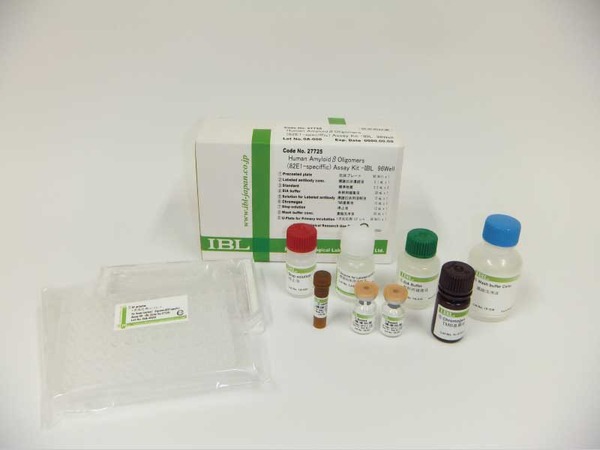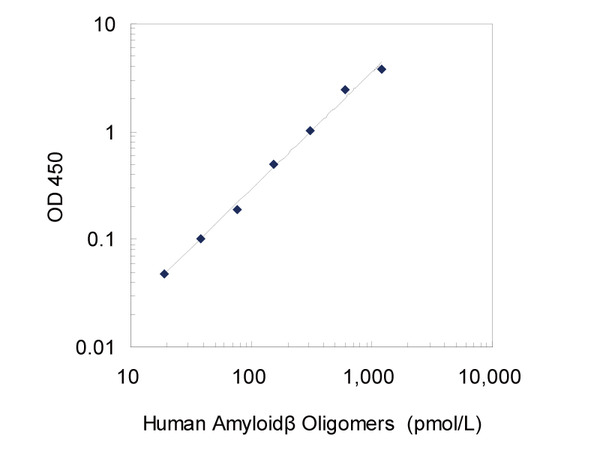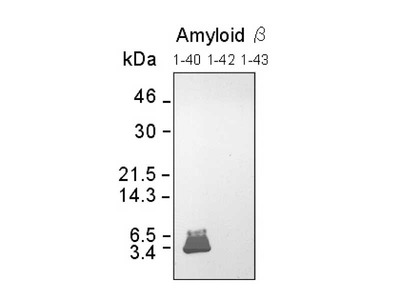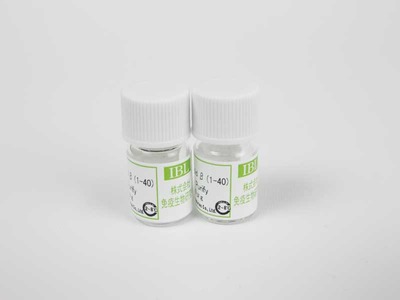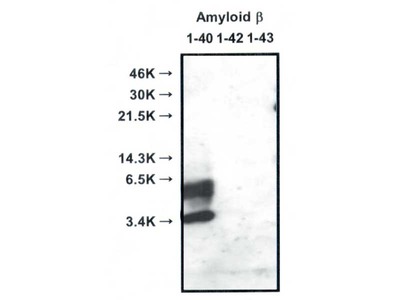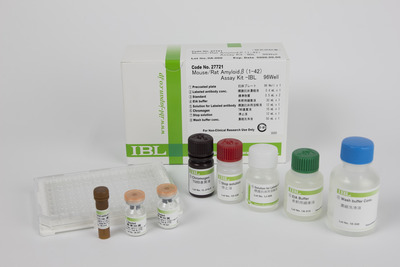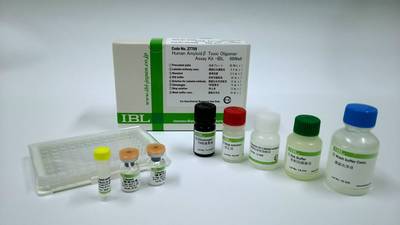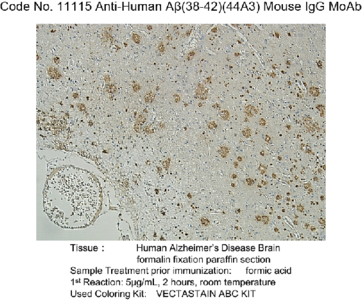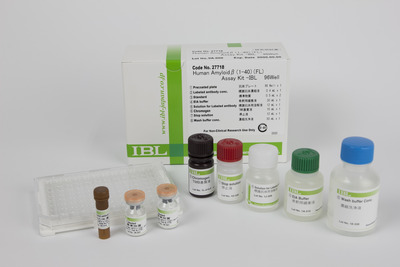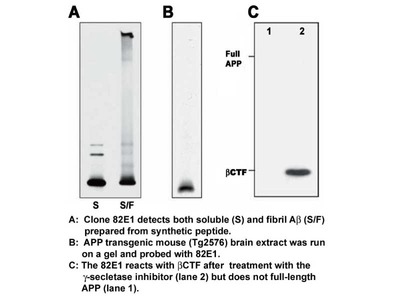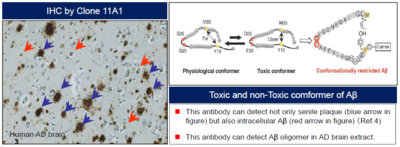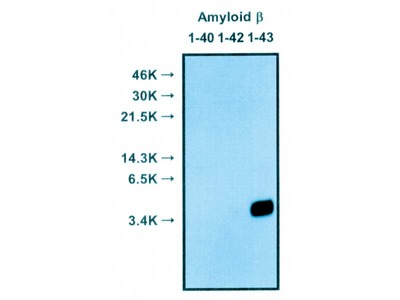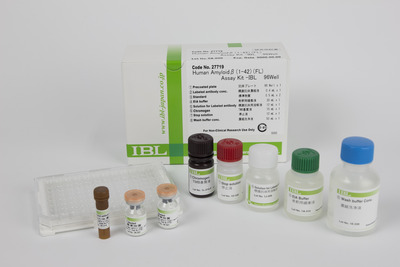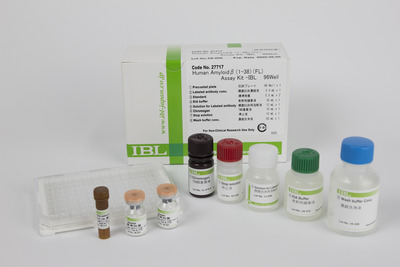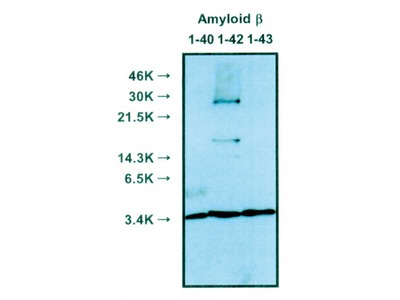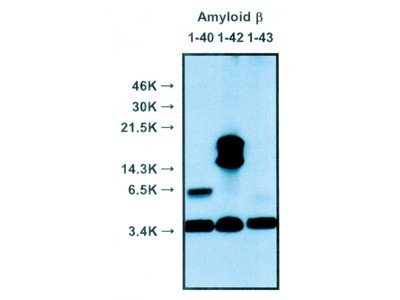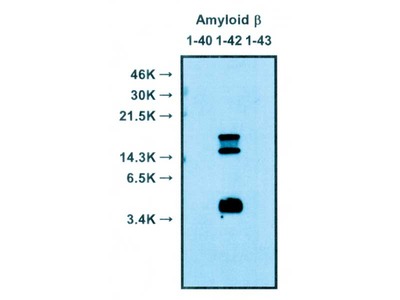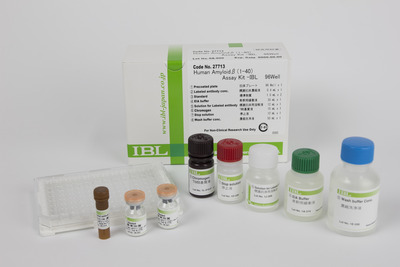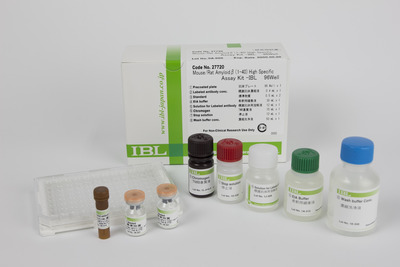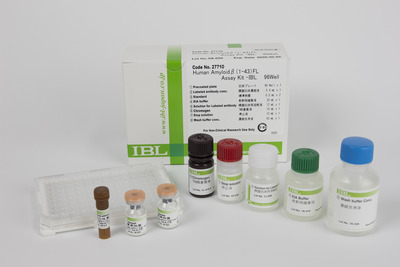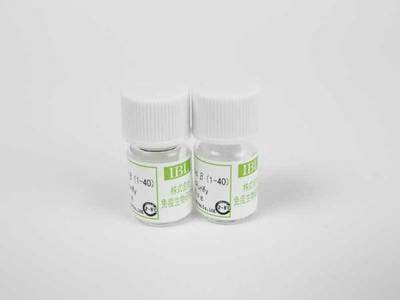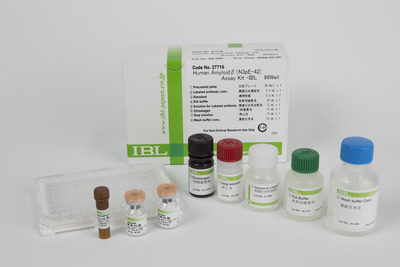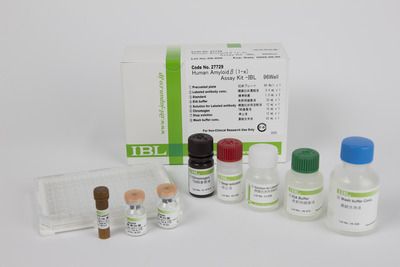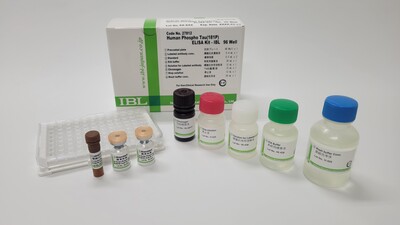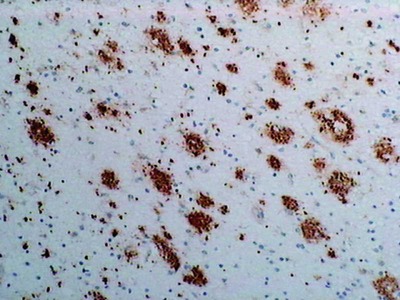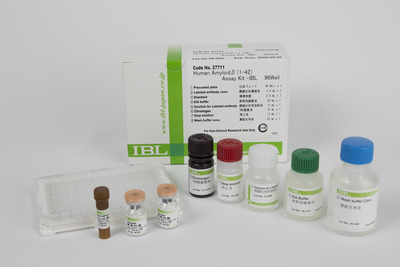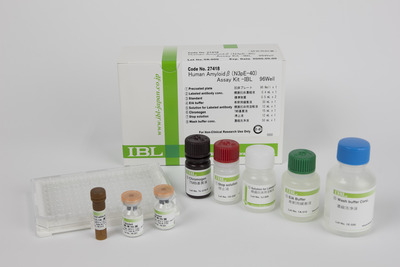- HOME >
- For Researchers >
- Product Search >
- Search Result >
- #27725 Human Amyloidβ Oligomers (82E1-specific) Assay Kit - IBL
Product Search
#27725 Human Amyloidβ Oligomers (82E1-specific) Assay Kit - IBL
- Intended Use:
- Research reagents
- Measuring Method:
- ELISA
- Sample Types:
- Human
- Measuring Samples:
- EDTA-plasma, Serum, Brain tissue extract
- Measurement Range:
- 18.98 ~ 1215 pmol/L
- Package Size1:
- 96 Well
※ The product indicated as "Research reagents" in the column Intended Use cannot be used
for diagnostic nor any medical purpose.
※ The datasheet listed on this page is sample only. Please refer to the datasheet
enclosed in the product purchased before use.
Product Overview
Product Overview
| Product Code | 27725 |
|---|---|
| Product Name | Human Amyloidβ Oligomers (82E1-specific) Assay Kit - IBL |
| Intended Use | Research reagents |
| Measuring Method | ELISA |
| Conjugate | HRP |
| Species | Human |
| Measuring Samples | EDTA-plasma, Serum, Brain tissue extract |
| Measurement Range | 18.98 ~ 1215 pmol/L |
| Primary Reaction | 60 minutes at 2 - 8 ℃ |
| Secondary Reaction | 60 minutes at 2 - 8 ℃ |
| Sensitivity | 4.41 pmol/L |
| Specificity | Compound Cross Reactivity Aβ (1-16) dimer peptide 100.0% Aβ (1-40) peptide 0.27% Aβ (N3pE-40) peptide ≦ 0.1% Aβ (N3pE-42) peptide ≦ 0.1% |
| Storage Condition | 2 - 8 ℃ |
| Poisonous and Deleterious Substances | Not Applicable |
| Cartagena | Not Applicable |
| Measuring Service | Not Available |
| Package Size 1 | 96 Well |
Product Description
Product Description
Alzheimer's disease (AD) is a neurodegenerative disease which Amyloid beta (Aβ) peptide accumulates in a brain and the predominant symptom is a decline of cognitive functions. It has been generally thought that Aβ which condenses and become insoluble fiber (fibril) forms the senile plaque and this denatures neurons and develops the symptoms of the disease. (This is called the 'amyloid hypothesis'.) However, 'oligomer hypothesis' is becoming potent these days that the disease is developed by decline in cognitive function because of the soluble Aβ oligomer which is a middle object of a condensation process has strong synaptic injurious effects. It is reported that when the Aβ oligomer which is secreted from the cell or is extracted from the brain of individuals who suffer AD is injected into rat brain, it causes synaptic dysfunction and study memory loss. Moreover, it is also actually observed that the Aβ oligomers are increasing in brains of individuals who suffer AD compared with healthy individuals. IBL has many other kinds of Amyloidβ-related products for AD research. They are very specific assay systems for each target and they can be used according to the purpose of study.
Kyewords:
Alzheimer's Disease / Amyloid β / Amyloid-β/ Amyloid Beta / Beta Amyloid / Aβ / Oligomers / Toxic Oligomers
Kyewords:
Alzheimer's Disease / Amyloid β / Amyloid-β/ Amyloid Beta / Beta Amyloid / Aβ / Oligomers / Toxic Oligomers
References
References
- Oral Immunization with Soybean Storage Protein Containing Amyloid-β 4-10 Prevents Spatial Learning Decline. Kawarabayashi T et al. J Alzheimers Dis. 2019;70(2):487-503.PMID: 31177217
- Combined treatment with the phenolics (-)-epigallocatechin-3-gallate and ferulic acid improves cognition and reduces Alzheimer-like pathology in mice. Mori T et al. J Biol Chem. 2019 Feb 22;294(8):2714-2731.PMID: 30563837
- Combination therapy with octyl gallate and ferulic acid improves cognition and neurodegeneration in a transgenic mouse model of Alzheimer's disease. Mori T et al. J Biol Chem. 2017 Jul 7;292(27):11310-11325.PMID: 28512130
- Taxifolin inhibits amyloid-β oligomer formation and fully restores vascular integrity and memory in cerebral amyloid angiopathy. Saito S et al. Acta Neuropathol Commun. 2017 Apr 4;5(1):26.PMID: 28376923
- Methylene blue modulates β-secretase, reverses cerebral amyloidosis, and improves cognition in transgenic mice. Mori T et al. J Biol Chem. 2014 Oct 31;289(44):30303-17PMID: 25157105
- Environmental enrichment ameliorated high-fat diet-induced Aβ deposition and memory deficit in APP transgenic mice. Maesako M et al. Neurobiol Aging. 2012 May;33(5):1011.e11-23.PMID: 22197104
- A Food and Drug Administration-approved asthma therapeutic agent impacts amyloid β in the brain in a transgenic model of Alzheimer disease. Hori Y et al. J Biol Chem. 2015 Jan 23;290(4):1966-78.PMID: 25468905
- Granulocyte-colony stimulating factor attenuates oligomeric amyloid β neurotoxicity by activation of neprilysin. Doi Y et al. PLoS One. 2014 Jul 25;9(7):e103458.PMID: 25062013
Note: Retrieve by PMID number in displayed by abstract: http://www.ncbi.nlm.nih.gov
FAQ
FAQ
-
 Q.What size of oligomer can be detected by this assay kit?
Q.What size of oligomer can be detected by this assay kit? -
 A.Any oligomer that is bigger than Amyloidβ dimer and has a recognized region of 82E1 (N-terminal of 1-16) can be detected by this assay kit.
A.Any oligomer that is bigger than Amyloidβ dimer and has a recognized region of 82E1 (N-terminal of 1-16) can be detected by this assay kit. -
 Q.Can this kit detect protofibril and fibril?
Q.Can this kit detect protofibril and fibril? -
 A.It cross reacts with both protofibril and fibril.
A.It cross reacts with both protofibril and fibril. -
 Q.3 recognized parts of 82E1 antibody (a.a. 1-16) are existed if the sample is trimer. In that case, does the conjugated antibody binds to 2parts or only one part?
Q.3 recognized parts of 82E1 antibody (a.a. 1-16) are existed if the sample is trimer. In that case, does the conjugated antibody binds to 2parts or only one part? -
 A.82E1 antibody is used for as capture antibody (precoated one) and detection antibody (HRP conjugated one). Theoretically, 2 regions of trimer can bind to the detection antibody if 1 region is captured by captured antibody. However, this is only the case that actual molecule detected holds the N-terminal region of Aβ1-16.
A.82E1 antibody is used for as capture antibody (precoated one) and detection antibody (HRP conjugated one). Theoretically, 2 regions of trimer can bind to the detection antibody if 1 region is captured by captured antibody. However, this is only the case that actual molecule detected holds the N-terminal region of Aβ1-16. -
 Q.Is it depending on the size of oligomer to determine the quantity of the detection antibody that binds to one oligomer?
Q.Is it depending on the size of oligomer to determine the quantity of the detection antibody that binds to one oligomer? -
 A.It depends on molecule of oligomer. It does not detect monomer. We recommend to use both products #27718 Human Amyloidβ (1-40) (FL) Assay Kit - IBL and #27719 Human Amyloidβ (1-42) (FL) Assay Kit - IBL by depending on purposes.
A.It depends on molecule of oligomer. It does not detect monomer. We recommend to use both products #27718 Human Amyloidβ (1-40) (FL) Assay Kit - IBL and #27719 Human Amyloidβ (1-42) (FL) Assay Kit - IBL by depending on purposes. -
 Q.What is recommended dilution ratio for serum samples?
Q.What is recommended dilution ratio for serum samples? -
 A.It is 2 to 8 fold.
A.It is 2 to 8 fold. -
 Q.Is composition of EIA buffer of each ELISA kit all same? Can it be mixed to use?
Q.Is composition of EIA buffer of each ELISA kit all same? Can it be mixed to use?
ELISA common FAQ -
 A.No it isn't. As constitute of each EIA buffer is different, it cannot be mixed with other lots or EIA buffers contained in other kind of ELISA kits.
A.No it isn't. As constitute of each EIA buffer is different, it cannot be mixed with other lots or EIA buffers contained in other kind of ELISA kits. -
 Q.What is the composition of concentrated wash buffer?
Q.What is the composition of concentrated wash buffer?
ELISA common FAQ -
 A.It contains ordinary Tween and phosphate buffer (0.05% Tween-20 in PB).
A.It contains ordinary Tween and phosphate buffer (0.05% Tween-20 in PB). -
 Q.What is the feature of the plate?
Q.What is the feature of the plate?
ELISA common FAQ -
 A.We use plate that is flat bottom and removable strip type plate (8wellx 12 strips).
A.We use plate that is flat bottom and removable strip type plate (8wellx 12 strips). -
 Q.Can I re-use standard after reconstitution?
Q.Can I re-use standard after reconstitution?
ELISA common FAQ -
 A.Not recommended to re-use standard after reconstitution. Please use it at once after the reconstitution.
A.Not recommended to re-use standard after reconstitution. Please use it at once after the reconstitution.
Please note that there are some exceptions. One time freeze-thaw the standard is acceptable for use after reconstitution for some ELISAs.
Please check the details on each product datasheet. -
 Q.What is different between reagent blank and test sample blank?
Q.What is different between reagent blank and test sample blank?
ELISA common FAQ -
 A.Reagent blank means a well is only added EIA buffer and the purpose is confirming whether the Test sample value is influenced by lack of washing process or other operations. Test sample blank means a well is added EIA buffer and HRP antibody and the purpose is to calculate the background.
A.Reagent blank means a well is only added EIA buffer and the purpose is confirming whether the Test sample value is influenced by lack of washing process or other operations. Test sample blank means a well is added EIA buffer and HRP antibody and the purpose is to calculate the background. -
 Q.How many samples can be measured by this kit?
Q.How many samples can be measured by this kit?
ELISA common FAQ -
 A.The pre-coated plate contained in our ELISA kit is 96 wells plate. We recommend to use 16 wells (2 slits) for standard and 80 wells (10 slits) for 40 samples in duplicate.
A.The pre-coated plate contained in our ELISA kit is 96 wells plate. We recommend to use 16 wells (2 slits) for standard and 80 wells (10 slits) for 40 samples in duplicate. -
 Q.What is LOD (Limit of Detection)?
Q.What is LOD (Limit of Detection)?
ELISA common FAQ -
 A.It (LOD) is defined as sensitivity that is calculated using the NCCSL method. Please refer to a datasheet of each product.
A.It (LOD) is defined as sensitivity that is calculated using the NCCSL method. Please refer to a datasheet of each product. -
 Q.What is LOQ (Limit of Quantification)?
Q.What is LOQ (Limit of Quantification)?
ELISA common FAQ -
 A.It (LOQ) is the lowest value of measurement (standard) range. Please refer to a datasheet of each product.
A.It (LOQ) is the lowest value of measurement (standard) range. Please refer to a datasheet of each product. -
 Q.What is the definition of Over Night (O/N) reaction?
Q.What is the definition of Over Night (O/N) reaction?
ELISA common FAQ -
 A.It means that the reaction is required more than 16 hours unless otherwise specifically defined it on a datasheet of each ELISA product.
A.It means that the reaction is required more than 16 hours unless otherwise specifically defined it on a datasheet of each ELISA product. -
 Q.What is the specification of quality control for ELISA product release?
Q.What is the specification of quality control for ELISA product release?
ELISA common FAQ -
 A.The information of specification is available on individual lot specific CoA. Please contact us with your reference lot number for obtaining of specific CoA.
A.The information of specification is available on individual lot specific CoA. Please contact us with your reference lot number for obtaining of specific CoA. -
 Q.What is the number (e.g. 432143214321) at the edge of strips of the plate?
Q.What is the number (e.g. 432143214321) at the edge of strips of the plate?
ELISA common FAQ -
 A.According to the plate maker (ThermoFisher), it does not have any specific meaning as it is just the number of molds.
A.According to the plate maker (ThermoFisher), it does not have any specific meaning as it is just the number of molds. -
 Q.How to wash an ELISA plate?
Q.How to wash an ELISA plate?
ELISA common FAQ -
 A.Washing it by an auto-washer is highly recommended.
A.Washing it by an auto-washer is highly recommended.
If it is not available, please refer to the demo video (only 2 mins) using a washing bottle. -
 Q.The wells turned black during the test with the kit.
Q.The wells turned black during the test with the kit.
ELISA common FAQ -
 A.It is possible that the wells were not washed sufficiently during the washing process after the HRP-labeled antibody reaction.
A.It is possible that the wells were not washed sufficiently during the washing process after the HRP-labeled antibody reaction.
Be sure to wash the wells enough times as described in the data sheet with washing buffer of more than 350 µL.

